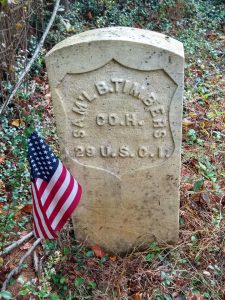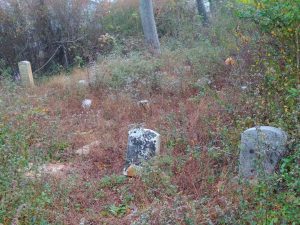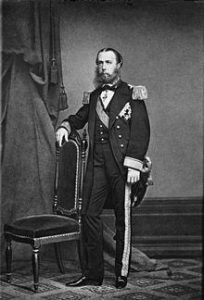In the October 2020 Lovettsville Historical Society Newsletter, there was a story entitled “Hidden History: Mount Sinai Church and Cemetery at ‘Little Britain.’” My family has a connection to the cemetery that I would like to share with you.

I am a fifth-generation descendant of Private Samuel Benjamin Timbers, whose grave marker stands in the Mount Sinai Church cemetery. As a proud veteran myself, I was overjoyed when I discovered this information a year ago while researching my family’s genealogy. I was aware that African Americans from Loudoun County, Virginia had served in the Civil War, but had no idea that a member of the Timbers family had served in the Civil War.
Samuel was born sometime between 1845 and 1847. His mother was Ann Maria Timbers (daughter of Margaret Timbers) and his father was Elijah Nelson. At the age of 18 (although I suspect that he may have been much younger), he enlisted at Baltimore, Maryland on October 17, 1864, to serve one year as a member of the 29th U.S. Colored Infantry.
Samuel was deployed to Petersburg, Virginia in November 1864. Sometime in December 1864, Samuel got sick and was admitted to a military hospital in the area. In February 1865, Samuel was ordered detached from his company and was reassigned to the Quartermaster Department at Division Headquarters for the rest of his service as a teamster with the Division wagon train (which normally would carry equipment and supplies, as well as baggage, to the soldiers or camp). Samuel, being detached from his company, was most likely in the rear with the wagon train and probably wouldn’t have been on the front lines in combat.
By the time Samuel got out of the hospital, the Army of The James had been reorganized into two Corps, one white (XXIV) and one black (XXV). The Army of The James was a Union army that was composed of units from Virginia and North Carolina. They served along the James River and in the final stages of the Siege of Petersburg up through the fall of Petersburg on April 2, 1865. Samuel’s regiment became part of the 25th or “XXV Corps.” The XXV Corps was unique because it was formed entirely from the USCT (U.S. Colored Troops) regiments from other commands and was the only entirely African-American corps in the Union Army. Though Samuel experienced several more sickness episodes, his unit served in the trenches and they were were some of the first soldiers to reach Petersburg and Richmond on the morning of April 3, 1865.
On April 9, 1865, soldiers from both Corps fought Robert E. Lee’s Army of Northern Virginia at Appomattox Court House and successfully blocked the Confederate soldiers’ westward advancement. With no escape routes for Lee’s Army and more Union forces on the way, General Lee surrendered that afternoon. The men of the XXV Corps had played a vital role in Lee’s decision.
After Lee’s surrender, the Corps spent a month in the area surrounding Richmond. The XXV Corps was then deployed to Texas as an occupation force, guarding the border with Mexico as well as watching for resurgent Confederate activity. This proved to be a miserable, disease-ridden assignment, killing hundreds of soldiers. The regiments began to muster out of service in late 1865. Samuel was discharged on November 6, 1865 at Brownsville, Texas, and returned home to the Lovettsville area. As soldiers of the XXV Corps began returning home, they had earned the right to be proud of their service and accomplishments defending their country.
Upon returning home, Samuel married Julia Ann Spriggs on July 23, 1870. He and his wife and family are listed in the 1880 federal census for Lovettsville, Virginia: Samuel (age 30), his wife (25), and five daughters are listed: Annie M. (10), Alice (9), Matilda (8), Ida (3), and Bessie (6 months). Missing from this family group was a son (Joseph) born in 1883. Joseph relocated to Leesburg, Virginia and married Martha Johnson. He worked in the Leesburg Lime Quarry, and his wife Martha was a cook. They had seven children (Samuel J, James W, William L, Annie M, Harriet M, Rosa, and Blauche).
Since this discovery, I have often wondered why Samuel decided to leave his family to serve his country. As a free man (as noted in the Loudoun County Record of Free Negroes 1844-1861) who could read and write, perhaps his motive had something to do with his attitude towards slavery, or maybe he simply wanted to escape the farm work routine which was quite common in those days. I simply can’t imagine the risks and dangers he faced traveling over the rough and dusty countryside, nor can I fathom some of the sights he must have seen. I wonder about the level of care he received in racially segregated hospitals. I also wonder what he must have felt to have played a role in the history of this country as he may have witnessed Lee’s surrender at Appomattox. I wonder if he shared any stories about his year-long experience in the Civil War.
With the limited amount of documentation I have, I’ve not been able to adequately paint a picture of Samuel’s life after returning home. I have learned however, that on June 13, 1892, Samuel was awarded his Civil War pension. He died January 11, 1912 at the age of 65 as a widower, and was laid to rest in the Mount Sinai Church Cemetery.

On a personal note, I too was born and raised in Loudoun County and enlisted in the Air Force in 1968 after graduating from Loudoun Valley High School. After my discharge in 1972, my wife Sharron (who also graduated from Loudoun Valley High School a year after me) and I relocated to Syracuse, New York to attend college. We graduated from Syracuse University and decided to remain in the area to raise our daughter Fraezeel and to be close to our two grandchildren (Jaidyn and James Howard). We both have family still living in Loudoun. This year when I celebrate Veterans Day, I plan to light a candle and fly our flag in remembrance of my relative and in honor of his service to our country.
Howard Gilbert Timbers Jr.
gmalovespp@gmail.com
Addendum: Why was Samuel Timbers on the Mexican border?
By Edward Spannaus
Throughout the last years of the Civil War, President Lincoln and General Ulysses Grant regarded the French-Habsburg occupation of Mexico not only as a violation of the Monroe Doctrine, but a threat to the Union itself.
Under the pretext of debt-collection, Napoleon III of France had sent an army of occupation into Mexico in early 1862 and installed a puppet regime under the Hapsburg Prince Maximilian of Austria, ousting the democratically-elected government of President Benito Juarez.
On May 5, 1862, Juarez’s forces defeated French forces in the Battle of Puebla; their victory prevented Napolean III from supplying Confederate forces for at least a year. The inability of the French to supply munitions, and especially artillery, to Confederate forces made a major contribution 14 months later to the Union victory at Gettysburg. After the War, Latinos and Union veterans in the western United States celebrated the Mexican victory at Puebla, and the Mexican-Union alliance, every May 5, which became known as “Cinco de Mayo.”
Despite their loss at Puebla, the French and Maximilian held on in Mexico, and entertained dreams of an alliance with the Confederacy — if not outright annexation. And the Confederacy looked to French-occupied Mexico for trade, arms, and a place of refuge, and it continued to seek recognition as an independent nation from both Britain and France. Had the Confederacy successfully seceded from the United States, it would, out of weakness, have had to link up with either the British or the Hapsburg Empire.

On the other side, Lincoln and Grant ardently supported the Mexican Constitutionalists under Benito Juarez. Grant saw the French occupation as an effort to establish a monarchy and “a direct act of war against the United States.” As soon as was possible – that is, after Lee’s surrender at Appomattox — Grant sent Phil Sheridan with 50,000 troops to pacify Louisiana and Texas. In fact, Grant hoped that Sheridan would link up with Juarez to overthrow Maximilian and keep monarchy out of the Western Hemisphere. Sheridan, like Grant, viewed the overthrow of Maximilian as the final phase of the Civil War.*
Among the U.S. troops sent to Texas in May 1865 was the entire XXV Corps, led by General Godfrey Weitzel, a German immigrant and West Point graduate, who had been Chief Engineer of the Army of the James. He had been appointed to command the newly-created, all-Black XXV Corps in December 1864. It was Gen. Weitzel who accepted the surrender of Lee’s Confederates at Richmond on April 2, 1865. He and his troops took possession of Richmond and extinguished the fires which Confederate troops had set before fleeing the city, and restored order within days.
The three brigades of the XXV Corps’ Second Division (the 29th U.S.C.I. was part of the 3rd Brigade of the Second Division) proceeded from Richmond to City Point (where the Appomattox and James Rivers converge) on May 25, and were then transported by boat to Hampton Roads, where they boarded ocean steamers for the trip to the Gulf of Mexico and the landing in Texas.
The XXV Corps was headquartered at Brownsville on the Rio Grande, the southernmost city in Texas. The Second Division was sent about 100 miles up the Rio Grande to Ringgold Barracks near Rio Grande City. Pvt. Timbers’ muster rolls for July and August 1865 show him stationed at Ringgold Barracks.
They were there to prevent Napoleon III’s French troops — augmented by ex-Confederates — from crossing into Texas, and also to guard against any resurgent Confederate activity on the Texas side of the river. Maximilian was reported to be planning to recruit at least 100,000 ex-Confederates to join French forces in facing down Sheridan on the Rio Grande. This was combined with plans to set up a Confederate colony in northern Mexico, which would be supported by growing coffee.
But all this came to naught, in large part due to the presence of federal troops in Texas and California who blocked the hoped-for emigration of ex-rebels to Mexico. Along with this, Sheridan was providing clandestine aid to Juarez. Under this pressure from the U.S, Napolean III announced in early 1866 that he was withdrawing French troops from Mexico. Maximilian remained as “Emperor” for another year, until he was captured and executed by the restored Juarez government in June 1867.
The XXV Corps remained on the Rio Grande until January 1866, when it was disbanded and its remaining regiments mustered out. Many of its regiments had already been discharged, as was the case with Samuel Timbers’ 29th U.S.C.I., which was mustered out in November 1865 at Brownsville.
After the war, General Weitzel gave his assessment of the performance of Black troops in the XXV Corps: “Its organization was an experiment which has proven a perfect success. The conduct of its soldiers has been such to draw praise from persons most prejudiced against color, and there is no record which should give the colored race more pride than that left by the 25th Army Corps.”
* An indication of how Union troops viewed the situation in Mexico, long after the Civil War, is reflected in an account of the reunion of Loudoun Rangers held at Waterford in 1910. The National Tribune (the national GAR newspaper), reported on Oct. 6, 1920, that “Briscoe Goodhart delivered an address on what the Confederacy represented and some of its monarchical tendencies and its connection with the Maximillian Government of Mexico.” Although some ex-Confederates attended, there is no indication that any Black troops were present. Wouldn’t it have been interesting if Samuel Timbers had been there to tell his story of being part of the “Army of Occupation” along the Rio Grande?

